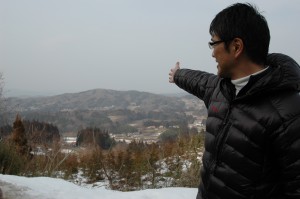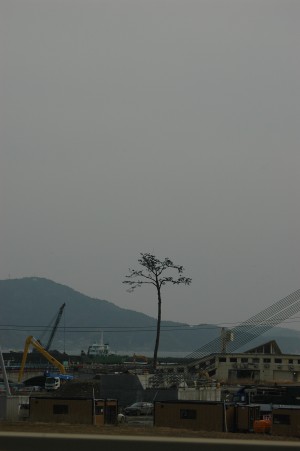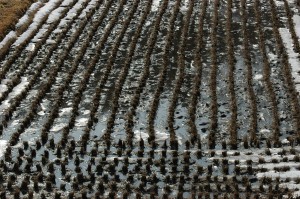Ichinoseki
Ichinoseki would be one of the main hubs of ILC life. It’s a city with a major train station, hospitals, shopping centres, and nearly 130 000 inhabitants, spread over a rather large area – over 1200 square kilometres, which is nearly 10 times the size of Geneva (Switzerland). This is because it was merged into one big city from many smaller communes in 2005. One of its most outstanding features: one of the biggest ILC fans in the area also happens to be the mayor, Osamu Katsube. Even before the ILC existed or he became mayor, during times when the Japan Linear Collider or JLC was being considered, he was part of a linear collider planning office in Iwate prefecture government. He has a 30-centimetre mascot of himself which also features on his business card – a grand man with a grand plan.
Iwate
Iwate is a prefecture of Japan. After Hokkaido it is the second largest prefecture and forms the Tohoku region together with Akita, Aomori, Fukushima, Miyagi and Yamagata. Its largest and capital city is Morioka, roughly an hour’s train ride north of the designated ILC site. The cities of Ichinoseki and Oshu are all in Iwate Prefecture. The Iwate Prefecture Government runs its own ILC office and coordinates activities with the ILC offices of Ichinoseki and Oshu.
Kitakami
Kitakami is the name for many things. LC NewsLine readers will know it as the name for the northern site. Kitakami can refer to the Kitakami river – the 5thlargest river in Japan, by the way, and very important for the prefecture because its river plain is home to much of the agriculture, which in majority are rice paddies. It can refer to the city, which is slightly smaller than Oshu and Ichinoseki and slightly further north.

The candidate interaction region could be under Hayama mountain, near Ohara City. Image: ILC/ Barbara Warmbein
And it is the name of a soft, rolling mountain range that runs through the prefecture from north to south, parallel to Kitakami river. Many access tunnels would be created under and into the Kitakami hills and mountains, and the interaction region would be under a mountain called Hayamayama near the town of Ohara. By the way, there’s some good hiking, paragliding and even skiing in the area. Town, river and mountains together make the place the “Kitakami region”.
Oshu
Oshu, like Ichinoseki, is a neighbouring city of the ILC if it was built in Iwate. It is the second largest city in Iwate Prefecture, and like Ichinoseki it is the result of a 2006 merger of several smaller communes. It has a gigantic sports stadium, a branch of the National Astronomical Observatory of Japan, all the amenities of a large city, famous cherry orchards, tasty cows and a high-tech Shinkansen station. What is more, it is the home of the International ILC Support Committee, a group of non-Japanese ILC fans who live in Iwate. The mayor of Oshu city and a group of officials came to visit CERN last year to explore the ways of an international lab.
Tohoku

This pine tree was the only survivor of its forest after the big 2011 Tsunami in Rikuzen Takata. Image: ILC/Barbara Warmbein
Many ILC researchers know the name Tohoku thanks to colleagues from Tohoku university situated in Sendai, notably Hitoshi Yamamoto, the LCC’s Associate Director for Physics and Detectors. Tohoku (Japanese for “northeast”) is the name for the northeastern region of Japan’s main island and comprises six prefectures, including Iwate (see above) and Miyagi, Sendai’s prefecture. It is also the name of the Shinkansen line that links Tokyo with the north east, so if you’re in Tokyo station looking for the right platform find the JREast Tohoku line. People from Tokyo are likely to tell you that “there be dragons” – that Tohoku is very, very cold and quite rural. As for the cold, yes, it was cold when we were there, but not much colder than Tsukuba or Tokyo, so it’s all a matter of perspective. And in comparison to Tokyo, everything will appear rural…
Tohoku is also the region that was most hit by the Great Earthquake and Tsunami of March 2011. One of its seaside towns, Kesennuma-port, would be very close to the 50-kilometre ILC end point. It is one of the towns most destroyed by the tsunami, and the reconstruction work that is going on in the area is impressive to say the least. A new highway is being built to link all towns along the coast, and the town of Rikuzentakata is even levelling out surrounding hills to rebuild it on higher ground and fill lower ground with the rubble from the hills to make it all more tsunami-safe. All communes have regular tsunami drills.
バーバラ・ワームベイン (Babara Wamubein)


Recent Comments